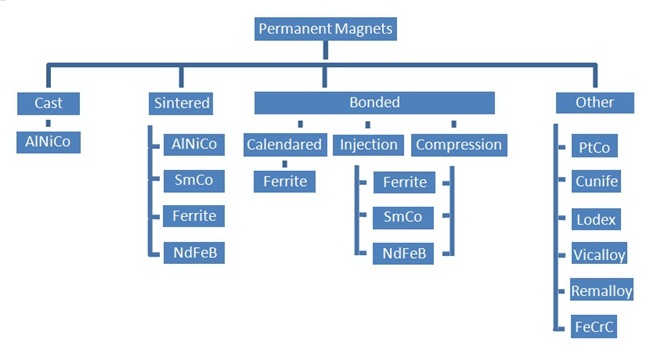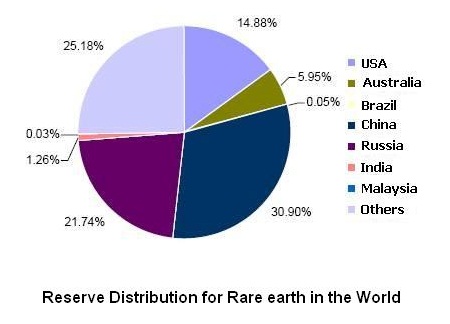1. Using strong magnetic force on iron, sintered ndfeb magnet can be used on chuck, separator, bag button etc.
2. Using vibration caused by the interaction of electromagnetic effect and magnetic field, sintered ndfeb magnet can be used on loudspeaker and earphones.
3. Based on the Electro-Magnetic Faraday principle, sintered ndfeb magnet can be used on wind turbine generator, sensor and switch.
4. According to charged conductor will be affected by ampere force, sintered ndfeb magnet can be used on PM motor.
5. Based on magnetism physical property of the Quantum of atomic scale, sintered ndfeb magnet can be used on NMR (Nuclear Magnetic Resonance).
When choose a magnet material, you need to figure out the requirement you need magnet to do in your application, but not blindly pursue high performance magnetic material; and then get a comprehensive understanding of different magnetic materials. If you have confusion on some point, you can ask for technical help from magnet specialist or manufacturer.
Magnet Material Magnetic Property Working Temperature Corrosion Resistance Magnet Price Remark NdFeB Magnet high low low high 1 Ferrite / Ceramic middle middle high low 3 SmCo Magnet high high high high 2 AlNiCo Magnet low high high middle 4
Ferrite and ndfeb magnet can be processed by sintering or bonding method. The Sintered magnet has high magnetic force, but poor formation. The bonded magnet has good formation, but low property.
Alnico can be processed by casting and sintering, the cast alnico has high property, but poor formation. The bonded alnico has good formation, but low property.
This is just a brief introduction for choosing magnetic material, please click here for more information.
Slice – to cut raw material from big into small, it is on direction of plane
Wire-electrode cutting – to cut raw material from big into small, it is for curved face machining and big size plane
Surface grinding – to grind plane for high dimensional precision
Forming grinding – to process curved face which has high requirement for precision
Ultrasonic drilling – to process small hole
Trepan boring – to process large hole
Chamfering – to process the sharp corner of product into round or bevel angle.
1. the king of magnet with very high magnetic properties
2. high coercive force
3. can be processed into many shapes
4. anisotropic material
5. one energy saving solution for many objects using magnet
6. get objects using magnet smaller
7. lose much magnetic force with increase of working temperature
8. high brittleness and difficult to process
9. low anti-corrosion capability, coating needed
Raw material Production – based on customer's requirement, to make property qualified material in a certain shape
Machining Process –based on customer's drawing, to process raw material into final shape
Surface Treatment –based on customer's requirement, to plate magnet to resist corrosion
Packing –based on customer's requirement, pack magnet by special carton with six-side iron sheets for air transportation, normal carton for sea transportation
N: general coercive force Hcj ≥12Koe, for example: N40
M: medium coercive force Hcj ≥14Koe, for example: N48M
H: high coercive force Hcj ≥17Koe, for example: N45H
SH: very high coercive force Hcj ≥20Koe, for example: N42SH
UH: great high coercive force Hcj ≥25Koe, for example: N438UH
EH: super high coercive force Hcj ≥30Koe, for example: N35EH
AH: Top high coercive force Hcj ≥35Koe, for example: N28AH
T: high requirement for corrosion resistance, for example: N45T
L-T: low temperature coefficient and high requirement for corrosion resistance, for example: L-38SHT
Figure represents the max energy product
Please visit here for more about grade of sintered ndfeb magnet
Neodymium Iron Boron Magnet contains rare earth metals like neodymium (Nd), metallic element iron (Fe), non-metallic element boron (B) and little trace elements, such as dysprosium (Dy), terbium (Tb), cobalt ( Co), niobium (Nb), gallium (Ga), aluminum(Al), copper (Cu), etc.
Neodymium Iron Boron Magnet is based on compound Nd2Fe14B. The molecular formula is similar with Nd2Fe14B. But the magnetic force will be very low or even no magnetic force with exact proportion of Nd2Fe14B. Only when the content of neodymium (Nd) and boron (B) in magnet is higher than nd and B in Nd2Fe14B, it can obtain better magnetic properties.
Neodymium magnet has high coercive force. That means it doesn’t lose its magnetic force and change magnetic property under ordinary circumstances over time.
We assume that the environment is stable (proper temperature & humidity, no strong external magnetic field, no radiation and others), the magnetic force only lose few even after a long time. So in an actual application, we can ignore the influence of time factor on magnetic force.
Description Abbreviation Unit SI Unit CGS CGS / SI Remanence Br T kGs 10 Coercive force Hcb KA/m kOe 4π/10³ Intrinsic coercive field Hcj,Hic KA/m kOe 4π/10³ Magnetic energy product BH max KJ/m³ MGOe 4π/10³ Magnetic force on Surface H KA/m kOe 4π/10³ Magnetic flow φ Wb, Vs Mx 108 Magnetic moment Mm A.m ² Vs.cm 10³ Magnetization intensity M T kGs 10
Note: Gs and Oe are the same numerical value, but two different physical significance units. So the magnetic field is the same by 1 Gs and 1 Oe.
103/4π=79.6
● Electro Nickel-Copper-Nickel: barrel plating and rack plating, good corrosion resistance,high temperature resistance.
● Electro zinc(blue white zinc and color zinc): barrel plating and rack plating,low operation temperature.
● Electrophoresis black epoxy: the organic protective coating for wet environment.
● Spraying grey epoxy: the organic protective coating for wet environments.
● Spraying Everlube: the organic protective coating, good corrosion resistance.
● Phosphorization(passivation): interprocess temporary protection.
● Electro tin, gold, silver etc.
● Physical Vapor Deposition(PVD): aluminum coating.
● Chemical Vapor Deposition (CVD): Parylen coating.
Ø Magnetic Flow (mWb): tested by coils on a magnetized magnet; magnetic flux is influenced by magnet remanence (Br), size, shape and coils.
Ø Magnetic Moment (vscm): tested by Helmholtz coil; there is only a coil coefficient differences between magnetic flow and magnetic moment.
Ø Surface Flux (Gs): the magnetic force at one point of magnet surface
Ø Irreversible Temperature Attenuation Coefficient for flux (moment): the percentage decline of flux (magnetic moment) after the magnet is placed at certain temperature for a certain time. It mainly depends on magnet intrinsic coercive field(Hcj), shape and size.
Ø Magnetic Declination: tested by 3D coil; the angle between the actual magnetization direction insde a magnet and the theory magnetization direction.

Ø Attractive Force: the interaction force of magnet and steel, depending on remanence(Br), the steel material and the contact mode.
Ø Remanence (Br): also called remanent magnetization; it is the magnetic flux density left behind in a magnet after an external magnetic field is removed when magnet get full magnetized.
Ø Sense magnetic coercivity (Hcb): the reversed magnetic field strength which enables internal magnetization intensity to zero when reverse magnetize a magnet. But the magnetization intensity is not zero actually. It means the reversed magnetic field needed and the magnetization intensity of magnet canceled each other.
Ø intrinsic coercivity (Hcj): the reversed magnetic field strength which enables magnetization intensity to zero.
Ø magnetic energy product (BH) max: the product of B and H at any point on the demagnetization curve; and the maximum value of B × H is called the maximum energy product.
Ø knee coercivity (Hk): the reversed magnetic field strength which enables magnetization intensity to reduce by 10% (or 5%)
Ø Square degrees: the ratio of Hk to Hcj; the theory limit is 1.
♥ Shape and required dimensions
♥ Injection and Compression Bonded or Sintered (full dense)
♥ Orientation(Anisotropic)or non-oriented(Isotropic)

Permanent magnet refers to hard magnet with high coercive force, high remanence which can keep constant magnetic force all the time once magnetized.It can be divided into two types:
1. Metal alloy magnets: Nd2Fe14B, SmCo, AlNiCo
2. Ferrite/Ceramic
At present, neodymium iron boron and ferrite are the most widely used magnetic material.
From strong to weak magnetic force, magnets can be listed as below:
Sintered NdFeb > Sm2Co17 > Sm1Co5 > Bonded NdFeB > AlNiCo > Ferrite
As the name suggests, rare earth magnets is a kind of magnet including rare earth metal. Rare earth metal family has 17 members including La, Ce, Pr, Nd, Pm, Sm, Eu, Gd, Tb, Dy, Ho, Er, Tm, Yb, Lu, Y, Sc. Rare earth metal Pr, Nd, Dy are used as the raw material of neodymium iron boron, and Sm is used as the raw material of samarium cobalt.

Rare earth metal is very expensive because it is rare resource. It also causes environmental damage in the process of mining. So some countries such as United State, Russia and Australia stop mining and purchase cheap rare earth material or product from China. The fluctuation in rare earth metal price is a very important factor of rare earth magnet price increase.

1. Neodymium Iron Boron Magnet
Sintered Neodymium Iron Boron Magnet is the most powerful and cost-effective magnet in the world. It is widely used in computer, motor, wind turbines, electric vehicles, instrumentation, magnetic drive bearing, high fidelity speakers, nuclear magnetic resonance (NMR) imaging, and aerospace navigator. It also plays a great role in new technologies such as maglev train. Cheap Pr-Nd metal replaces purity Nd to improve its resistance to oxidation and mechanical property. Dy is a kind of additive for high grade neodymium iron boron magnet. It can increase magnet coercive force just by 2-3% Dy. With magnet requirement for the high-end product increasing, the demand for Dy is also increasing.
2. Samarium Cobalt Magnet
SmCo is the earliest rare earth magnet in industry including SmCo5 and Sm2Co17. But Sm2Co17 is preferred material at present. The purity of samarium oxide used in SmCo magnet is not very high. From cost consideration, 95% samarium oxide product is enough.
Yes.There are two industry associations create a set of standards.
The Magnetic Materials Producers Association (MMPA) publishes standards for the production of magnetic materials
The Magnet Distributors and Fabrications Association (MDFA) produces standards on various ways of testing magnets and magnetic devices.
|
Material |
Approx. Maximum Operating Temperatures |
|
NdFeB |
200°C |
|
SmCo |
350°C |
|
Alnico |
550°C |
|
Ferrite |
250°C |
 China Magnets Source Material Limited
China Magnets Source Material Limited